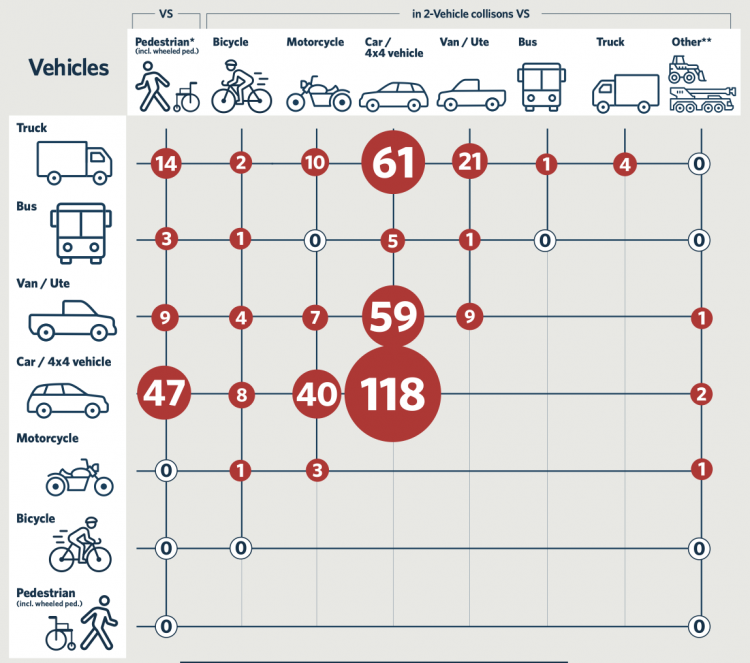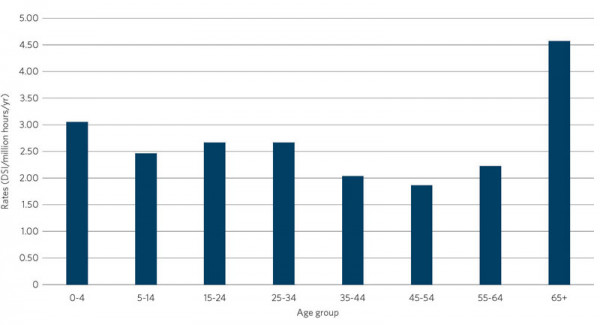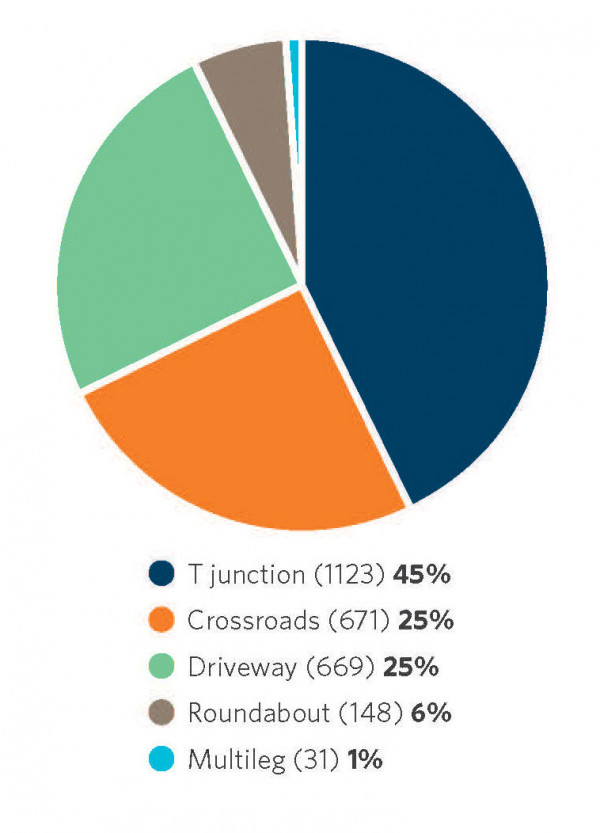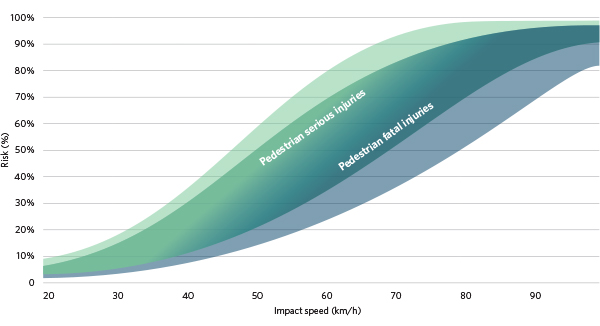Walking is the second safest mode after buses per hour spent travelling. However, in the last 10 years pedestrians were involved in about 22 percent of serious casualty crashes on urban roads, and around 11 percent nationally[3]. In the 10 years to 2019, 326 pedestrians were killed and 2,383 were seriously injured in road crashes (excluding wheeled pedestrians). 77 wheelchair and mobility scooter users were killed or seriously injured in that time. It is important to recognise that pedestrian crashes are under reported and under recorded in the crash analysis system (CAS) giving unrepresentative results.
On its own, walking is a very safe activity – as would be expected, the instance of two pedestrians colliding resulting in a fatality is extremely rare. The graphic below shows what road user types are involved in fatalities in the 2018 and 2019 years.

2018-2019 fatalities from crashes between two or more road users. (Source: Waka Kotahi NZ Transport Agency)
The main issue for pedestrian-involved crashes is that injuries are more severe. For instance, fatalities are a low proportion of cycling injuries but high for walking. This is because most pedestrian injuries involve higher impact speeds as they are crossing a car route operating at speed limit, but cyclists are hit by slow speed cars turning across cyclist route.
When I am crossing the road at an intersection, I can't hear traffic approaching so it can be scary. I avoid intersections where the traffic feels really fast because it's just too stressful. |
From 2015 to 2019, pedestrians accounted for about one in 10 (10.37%) of all road deaths in New Zealand. In the main urban centres, on roads subject to urban speed limits, about one in four road deaths (24.08%) were pedestrians.
Annually, an average of 34 pedestrians are killed and 905 are reported injured on New Zealand roads. While the number of pedestrians killed is trending downwards, reported pedestrian injuries have been unchanged for the last 15 years, despite the decline in walking by children who are the largest group at risk.[4]

Reported number of pedestrians killed and injured per 100,000 population.[5]
Note the different y-axis scales. In the mid 1980’s, there were approximately 4 fatalities and 40 injuries per 100,000 population (a ratio of 1 fatality for every 10 injuries). After 2000, the trend lines swap to less than 1 fatality and about 20 injuries per 100,000 population (a ratio of 1 fatality for every 20 injuries). The ratio of fatalities to injuries has roughly halved. During this same period, traffic speeds have dropped about 5km/h.[6]
It is also likely that the number of deaths and injuries directly attributable to road safety issues per capita is declining because the HHTS indicates there is less walking activity per capita; this is an area for further research as local authorities begin to collect finer grained data on walking along streets.
As well as objective risk as estimated by reported crashes, pedestrians’ perceptions of safety, and the accessibility of paths and crossings, affects their decision whether to walk or not in the first place[7]. Planning for pedestrian safety therefore requires consideration of how safe walking environments feel, and how accessible they are. Many people report that they will not walk when they do not feel safe. The alternative is that they will travel using another mode (such as public transport or car), or the trip will be foregone – with social and economic consequences related to inequity of participation.
Pedestrian friendly environments are where pedestrians feel safe from harm. Sufficiently wide footpaths which are separated from faster moving traffic is vital for pedestrian safety. Footpaths should have non-slip surfaces and no hazards which may cause slips, trips or falls. Good lighting and public surveillance are also important to make pedestrians feel seen and safe.
PNG: Principles of Safe, Obvious and Step-free
Both older and young pedestrians are at particular risk as they tend to have lower cognitive, sensory, and physical abilities. The bar graphic below shows the annual average number of deaths and serious injuries (DSIs) by age group (2014–2018 CAS data), divided by the total annual hours in millions for each age group as estimated by the Household Travel Survey.
The greatest risk is for people 65 and older, although younger people also have an elevated risk compared to those in the 35-64 age groups.[8]

Rate of pedestrian deaths and serious injuries in motor vehicle crashes by age group.
At a national level, crashes involving pedestrians occur mainly[11] :
For pedestrian-involved crashes in the five-year period from 2014 to 2018, 704 (41%) of controlled intersection crashes were at traffic signals (left image below) and 148 (6%) of junction crashes were at a roundabout (right image).

Reported pedestrian-involved crashes by control type, excluding 1279 uncontrolled intersection crashes, 2014–2018.

Reported pedestrian-involved crashes by junction type, excluding 3047 non-junction crashes, 2014–2018.
Considering the junction crashes, nearly half are at T-junctions and a quarter each are at driveways and crossroads. This points to a probable deficiency in the design of minor street / road intersections and potential issues with driveway inter-visibility as well as road user behaviours.
Police reported crash data is of little use when attempting to understand issues of safe travel for pedestrians other than vehicle-pedestrian incidents.[14] While road crash statistics are invaluable in identifying the sites and pedestrian groups with particular road safety issues, they do not provide any qualitative information, such as:
Moreover, pedestrian crashes and injuries that do not involve a motor vehicle or another road user, or that happen away from the roadway (eg falls due to poorly maintained footpaths or the pedestrian’s distraction, or alcohol impairment) are not included in the NZ Crash Analysis System, and often go unreported in other channels.[15]
Speed is a major factor in the severity of injury and likelihood of death in pedestrian, side impact and head on crashes.[16] A Safe System speed is typically defined as the impact speed[17] where the chance of death is less than 10% or the point on fatality risk curves on the graph below where this changes from shallow to steep.

The influence of collision impact speed on the risk of pedestrian death and severe injury. (Adapted from AAAFTS, 2011)
Corben (2020) states that:
It is increasingly accepted by road safety practitioners that, to be aligned with the Safe System philosophy for pedestrians and cyclists, 30km/h impact speeds define the upper limit of an ‘acceptable’ collision. This ‘Safe System boundary condition’ coincides with an approximate 10% chance of the struck pedestrian being killed by the collision. Put another way, this corresponds to a 90% chance of survival. For the corresponding situation with serious injury ( ie, a collision with a pedestrian producing a 10% chance of serious injury), a much lower impact speed applies.[18]
Corben also cites ITF’s conclusions on the topic:
Whilst there is, and will continue to be, considerable debate on safe impact speeds and the shape of various fatality risk curves, precise definitions are not possible or meaningful in reality. They represent some form of population average over a sizeable number of cases but there is considerable variability in outcomes, and hence risk, among individuals due to uncontrollable factors such as the type and size of the vehicle, the age and health status of the road user, the point of impact, etc. There is a certain randomness about these factors that is often beyond the control of the system designer or operator. Because of this variability in the incidence and circumstances of real world crashes, a conservative position should be adopted concerning risk so as to account for a broad range of population, vehicles and conditions. We must also be cognisant that the use of fatality risk curves, and the tenth percentile value to determine safe impact speeds, is by definition permitting the incidence of some deaths and serious injuries, notwithstanding the commitment to eradicating deaths and serious injuries from road crashes.[19]
Lower speeds can be achieved by designing ‘self-explaining’ streets (through road space allocation, traffic calming, etc). Setting the appropriate speed limit can be an additional low-cost approach, but is unlikely to achieve lower speeds as a sole treatment. Evidence by Koorey (2020) also suggests agencies may reduce speed limits (and travel speeds) to safe levels without seriously increasing travel time.[20]
Practitioners should refer to:
There's a busy road on my way to school and Mum and Dad say that there is too much traffic for me to walk, so they drive me. |
[3] Source: NZ Transport Agency Crash Analysis System (CAS) data (2010-2019)
[4] Ministry of Transport. (2017). Pedestrian Crash Facts 2017
[5] Sources: Ministry of Transport. (2005). Motor Vehicle Crashes in New Zealand (for data from 1970-1979)(external link). NZ Transport Agency Crash Analysis System (1980-2018). Data accessed 20 January 2020. Population data from Statistics NZ
[6] Ministry of Transport. (2013). Speed survey results – car speeds
[7] Burdett, B. (2017). Understanding Pedestrian Safety in New Zealand(external link), IPENZ Transportation Group Conference, Hamilton 29
[8] Ministry of Transport. (2017). Pedestrian Crash Facts 2017(external link)
[9] Population distribution is the usually resident values from the 2018 Census (source: Statistics NZ)
[10] Hirsch, L., Mackie, H., Scott, R. & Thorne, R. (2018). Understanding the Safe System context behind pedestrian road trauma in New Zealand. Auckland, New Zealand. Prepared by Mackie Research for Waka Kotahi NZ Transport Agency.
[11] Crash Analysis System (CAS) data accessed November 2019 unless otherwise noted; data is for the 2014–2018 five-year period
[12] Kokotailo, R. (2000). New Zealand pedestrian profile(external link)
[13] Pour, A.T., Moridpour, S., Tay, R., & Rajabifard, A. (2017, November). Using crash severity to identify safe walking distance in vicinity of schools. Australasian Transport Research Forum (ATRF), 39th, 2017, Auckland, New Zealand.
[14] Oxley, J., et al. (May 2018). Falling while walking: A hidden contributor to pedestrian injury(external link), Accident Analysis & Prevention 114, 77–82.
[15] Lennon, A., Williamson, A. et al. (2016). Distraction and Attitudes Towards Safe Pedestrian Behaviour, Austroads Research Report AP-R510-16
[16] Scott, R. & Mackie, H. (2018). Speed/injury Risk Curves: Analysis of evidence and considerations for updated curves(external link)
[17] In one study, about half of all fatally injured pedestrians were struck at the initial travel speed, ie the driver had not braked before impact; therefore it is appropriate to use the posted speed when interpreting Figure 15. Refer to Anderson R.W.G., McLean A.J., Farmer M.J.B., Lee B.H. & Brooks, C.G. (1997). Vehicle travel speeds and the incidence of fatal pedestrian crashes(external link), Accident Analysis and Prevention 29, 667–674.
[18] Corben, B. (2020). Integrating Safe System with Movement and Place for Vulnerable Road Users(external link). Austroads Research Report AP-R611-20
[19] International Transport Forum. (2016). Zero Road Deaths and Serious Injuries: Leading a Paradigm Shift to a Safe System(external link). OECD Publishing, Paris.
[20] Koorey, G. (2020). Does speed greatly affect travel time?(external link) Transportation Group NZ Conference 2020, Christchurch. 10–13 March.
[21] Waka Kotahi NZ Transport Agency. (2022). Speed Management Guide: Road to Zero edition